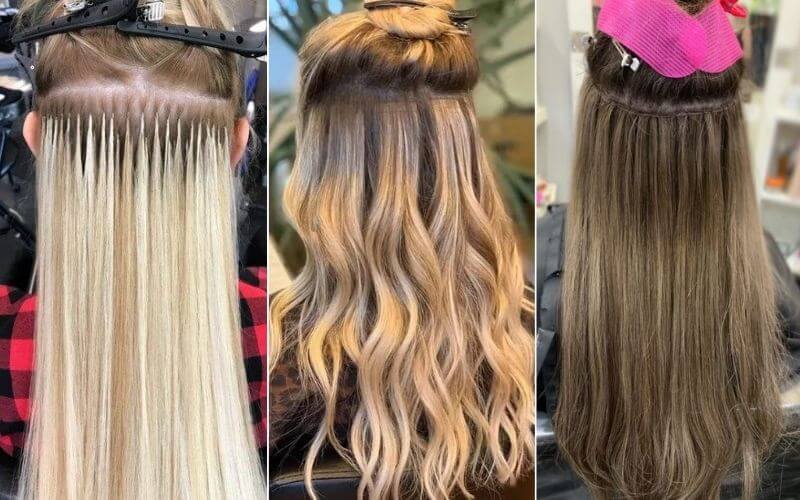Hair extensions are a fantastic way to transform your look and add length to your natural hair. Nevertheless, a frequent inquiry that emerges is, “How much do hair extensions cost?”. In this article, we will delve into various types of hair extensions and examine their respective expenses. Additionally, we will explore strategies for maximizing the value of your investment.
1. Different Types of Hair Extensions
Hair extensions come in a variety of forms, each with special qualities and cost ranges. Let’s analyze a few of the most common choices:

- Tape-In Hair Extensions: Tape-in extensions are attached using adhesive tapes. They offer a natural look, are easy to install, and typically last around 6-8 weeks. They are a great option for those looking for a semi-permanent solution.
- Clip-In Hair Extensions: Clip-in extensions are temporary and versatile. They can be easily attached and removed, making them ideal for special occasions or for those who want to change their hairstyle frequently without a long-term commitment.
- Sew-In Hair Extensions: Sew-in extensions involve braiding your natural hair and then sewing the extensions into the braids. This method provides a secure attachment and is popular among those seeking long-lasting extensions.
- Fusion/Keratin Hair Extensions: Fusion extensions are attached using a heat-activated keratin bond. They are highly durable and offer a seamless blend with your natural hair. Fusion extensions are suitable for those looking for a long-lasting solution.
There are three categories of hair extensions:
- Permanent Extensions: These extensions are designed to stay in your hair for an extended period, often lasting several months.
- Semi-Permanent Extensions: These extensions provide a moderate-duration solution, typically remaining in your locks for about 6 to 8 weeks.
- Temporary Extensions: These extensions are a short-term option, perfect for a day or a night out, and are easily removed once you return home.
>> SHOP NOW: HUMAN HAIR EXTENSIONS
2. How much are permanent hair extensions?

Permanent hair extensions offer long-lasting results. The cost of permanent hair extensions depends on factors such as the type of hair used, the application method, and the stylist’s expertise.
For a good set, professional/permanent hair extensions typically cost between $700 and $1,500. These need to be installed and removed by a professional (usually a licensed hairdresser), as well as regular maintenance.
3. How much are tape in hair extensions?

Tape-in hair extensions are a semi-permanent hair extension choice. Tapes are the quickest and easiest technique of applying and removing hair extensions after clip-ins. This type of temporary hair extension, unlike clip-ins, necessitates the aid of a skilled, professional hairdresser.
Tapes are normally 1 inch wide and are glued to the hair. Because they are applied to a large quantity of hair, tape-in extensions do not cause as much tension and breakage to natural hair as other permanent extension procedures.
Tape-in extensions cost different amounts based on the salon you visit, the length and quality of your hair, and other considerations. They are easier to install and might cost between $200 and $600 for a full head.
4. How much are fusion/keratin hair extensions?

Fusion extensions are attached to your natural hair using a heat-activated keratin bond. They are known for their durability and seamless blending with your hair.
The cost of fusion hair extensions can vary significantly based on several factors, including the quality of the hair, the location of the salon, the expertise of the stylist, and the number of extensions needed. On average, you can expect to pay anywhere from $300 to $800 or more for a full head of fusion extensions Additionally, they need to be reset at the hair salon roughly every three months.
5. How much are sew in hair extensions?

Sew-in extensions are braided into your natural hair, offering a secure attachment. They can cost between $200 and $800, depending on the type of hair and the stylist’s fees.
6. How much are beaded hair extensions?

The cost of beaded extensions, also known as I-Tip extensions, can vary based on several factors, including the quality of the hair, the salon or stylist you choose, your location, and the number of extensions you need. On average, you can expect to pay between $300 and $800 for a full head installation of beaded extensions.
7. How much do clip in extensions cost?

Clip-in hair extensions are a type of extension where hair is affixed to a small metal clip, which is then fastened into your natural hair. These extensions are typically crafted from 100% real human hair, granting you the flexibility to style them just like your own hair. You have the option to curl, straighten, or even dye them as needed.
The average price range for clip-in hair extensions falls between $50 and $200, contingent on the hair’s length. Their durability typically spans from 6 to 12 months, depending on how frequently you use them.
8. How much are halo hair extensions?

Halo extensions are a one-piece extension that sits on top of your head like a halo. They are generally priced between $200 and $400.
9. How much do nano hair extensions cost?

Nano tip extensions stand out as the most inconspicuous hair extensions available today. If you desire to increase both length and volume in your hair without resorting to glue, heat, or braids, Nano hair extensions present the ideal solution. Each Nano tip has an aluminum wire that fits into the nano rings, the smallest ring available. With the choice of silicone lining for additional protection available in a wide range of colors to match perfectly to your hair.
The cost of nano hair extensions can vary depending on several factors. On average, you can expect to pay between $300 and $800 for a full head installation of nano hair extensions.
10. How much are glue in hair extensions

Glue-in hair extensions use adhesive to attach the extensions to your hair. Prices vary, and the quality of the glue is a significant factor in the cost.
Please note that the quality of the hair plays a crucial role in pricing. Remy human hair extensions, which are known for their high quality, tend to be more expensive than synthetic or non-Remy options.
11. How to Get the Best Price on Hair Extensions
Getting the best value for your hair extensions involves a few key strategies and considerations. Here are some tips to help you save money and ensure that you’re making a wise investment:

Do Your Research
Before you make any decisions regarding your hair extensions, it’s essential to conduct thorough research. Understand the various types of hair extensions available and their associated costs. You’ll want to consider factors such as the type of hair, the method of attachment, and the longevity of the extensions.
Research also involves looking for reputable salons or suppliers with a track record of providing high-quality extensions. Reading reviews and seeking recommendations from friends or online forums can provide valuable insights into your choices.
Buy Hair Extensions from Hair Suppliers Directly
One way to potentially lower the cost of your hair extensions is by purchasing them directly from hair suppliers. This cuts out the middleman, such as a salon or distributor, which can often lead to cost savings. Additionally, buying from suppliers allows you to have more control over the quality of the hair itself.
Choose an Experienced Stylist
Selecting the right stylist is a critical decision when it comes to the cost and overall result of your hair extensions. Experienced stylists not only understand the nuances of applying extensions but also know how to match the color and texture of the extensions to your natural hair seamlessly. This expertise can save you money in the long run by ensuring that the extensions look and feel natural and that they last as long as possible.
Consider Package Deals
Some salons and stylists offer package deals that can provide cost savings. These packages often include both the hair extensions and the installation service in one bundled price. By opting for a package deal, you can potentially reduce the overall cost compared to purchasing the extensions and paying for installation separately.
12. The Factors That Influence Hair Extension Costs

The price of hair extensions can vary widely, and several key factors influence the overall cost. Understanding these factors can help you make an informed decision when investing in extensions:
- Quality of Hair: The quality of the hair used for extensions is a significant cost factor. Remy human hair, known for its natural appearance and durability, tends to be more expensive than synthetic or non-Remy options. High-quality hair also retains its luster and texture longer.
- Type of Extensions: Different methods of attaching hair extensions come with varying costs. Permanent extensions, such as fusion or sew-in, are generally more expensive than temporary options like clip-in extensions. The method you choose depends on your desired longevity and look.
- Length and Volume: Longer hair extensions or a fuller head of hair will require more hair, which naturally increases the cost. The length and volume you desire will impact the overall price of your extensions.
- Stylist’s Expertise: The skill and experience of the stylist can influence the cost of hair extensions. Experienced stylists may charge higher fees for their services, but their expertise often results in a more seamless and natural appearance, which can be a worthwhile investment
- Geographic Location: The cost of hair extensions can vary based on your location and the local cost of living. Salons in major cities or high-cost areas may charge more for their services compared to those in smaller towns or regions with a lower cost of living.
13. Additional Costs Associated with Hair Extensions
While the initial cost of hair extensions is a significant consideration, it’s essential to be aware of additional expenses that may be incurred throughout your hair extension journey.

- Installation and Application: The installation or application of hair extensions is a separate cost from the extensions themselves. Depending on the type of extensions you choose, you’ll need to pay for the services of a qualified stylist to attach them securely. The price of installation can vary depending on the method used and the stylist’s expertise.
- Maintenance and Touch-Ups: Hair extensions, especially permanent ones, require regular maintenance and touch-ups to ensure they look and feel their best.
- Styling and Blending: Styling and blending your natural hair with the extensions may require additional products and tools. You might need to purchase specialized brushes, heat protectants, and styling products to maintain the extensions and create your desired look.
- Removal Costs: When the time comes to remove your extensions, you may need to pay for professional removal services to avoid damaging your natural hair.
Wrap Up!
By understanding the types of hair extensions available and the factors that influence their costs, you can navigate the options with confidence. Whether you choose permanent extensions like fusion or sew-in, or temporary options like clip-in or tape-in extensions, it’s important to weigh your preferences and budget.
In the end, the world of hair extensions offers endless possibilities for achieving the hair you’ve always wanted. With careful planning and a commitment to proper care, you can enjoy the benefits of beautiful, luscious locks that boost your confidence and complement your individual style.
𝑭𝒐𝒓 𝒎𝒐𝒓𝒆 𝒊𝒏𝒇𝒐𝒓𝒎𝒂𝒕𝒊𝒐𝒏, 𝒄𝒐𝒏𝒕𝒂𝒄𝒕:
Whatsapp: +84898890054
Follow us on Instagram: @ownhumanhairbusiness
Website: hairbusiness.org

